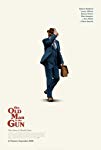Eye For Film >> Movies >> The Old Man & The Gun (2018) Film Review
The Old Man & The Gun
Reviewed by: Owen Van Spall

I don’t know if Robert Redford had told director David Lowery he was retiring from acting before signing on to The Old Man & The Gun, but this charming, graceful minimalist crime drama has turned out to be a thoroughly appropriate salute to the film icon. More interested in honouring Redford’s greatest hits and his legendary charisma than trying to follow the beats of other similar films about cops and crooks, The Old Man & The Gun doesn’t really suffer from making little effort to try to dissect the mind of a criminal or show the specifics of police procedurals. Instead, it acknowledges the power of charm and the success sheer boldness can bring, and the difficulty of stopping using those natural talents when you are so damn good. What better way to evoke the long arc of Redford’s career?
It also doesn’t hurt that Lowery has a genuinely remarkable true story to draw on, and one he tells in a way that suitably evokes not only the era in which most of the action takes place (the early Eighties), but the sort of intelligent and independent-minded movies Redford was making in his heyday. From the age-appropriate title design to the faded film grain (DP Joe Anderson shot on 16mm), The Old Man & The Gun effortlessly mimics visually the likes of Redford’s Seventies vehicles such as Three Days Of The Condor, while the subject matter recalls ‘caper’ flicks like The Sting and Butch Cassidy And The Sundance Kid.

A jaunty, evocative score from Daniel Hart is the icing on the cake. But Redford is the real fuel in this rocket, and he slips into the role of ageing, charismatic bank robber Forrest Tucker as easily as one might put on a comfy faded leather jacket. A lifelong criminal who’s story was told in David Grann’s New Yorker article of the same title, Forrest Tucker was a sort of self-styled ‘Houdini’ crossed with John Dillinger, who didn’t just rack up an astonishing list of bank robberies, but had an amazing run of audacious prison breaks too, which ranged from abseiling from a third-storey window via chains of blankets to an Alcatraz flight in a homemade kayak. But his real MO was to display a charming, garrulous persona during his stick-ups whilst avoiding violence, as if he was sweet-talking the bank out of its money. Everyone who was robbed by him seemed to enjoy it. If Tucker hadn’t been a real person, you would have had had to invent him so Redford could play him, so perfect is the fit.
The film opens in the 1960s, as Tucker hightails it from yet another robbery, having used pretty much the same method we will always see him deploy: he walks into a bank in a trenchcoat and snappy blue suit, politely wishes the clerk good morning, flashes his old colt 45 from its shoulder holster under the coat, and asks if the clerk would kindly fill the bag on the counter with cash. In our era of CCTV, DNA and drones, it seems hard to believe the same tactic would work today. But not having to face such police tools in the pre-digital era, and with a huge country to hide out in and find easy pickings, Forrest seems to have hit on a pretty surefire tactic. Stopping his car to let police cruisers roar by, Forrest encounters ranch owner and widower Jewel (veteran actress Sissy Spacek) who has broken down, and we soon are treated to a cinematic lesson in star chemistry as these two screen icons flirt with each other in an affectionately run-down diner late in the afternoon.
Jewel remains only a supporting character in Lowery’s film - drifting in and out of Forrest’s life over the next two decades - but that is kind of the point. As magnetic a guy as Forrest is, his seemingly never-ending desire to have the police on his tail at all times, to keep doing the thing he is best at for as long has can, means things like a steady partner and family have never factored into his thinking. In many ways, the purpose of Casey Affleck’s character - the aptly-named Detective John Hunt - is not so much to play the archetypal dogged cop figure to Redford’s cool crook, but to highlight what Forrest has lost out on.
Hunt, who pursues Forrest in the 1981 sequence of the film after a bank in his precinct area is taken down by the aged robber, is pushing 40 and has lost his mojo after years of seeing his closed case files merely replaced by yet more depressingly familiar ones. Yet we see that, for all his sense of drift, he has a warm family life with a wife he clearly loves and two charming kids he dotes on. When we see Forrest in a domestic setting, such as at Jewel’s handsome ranch, he looks as out of place as someone as glamorous as Redford would look pumping gas at a station, and it is a little sad.
A short scene around the middle of the film, which suggests an angle the film might have explored further to add interest, sees Hunt track down Forrest’s estranged daughter, and her uneasy interview suggests a father who left a trail of pain in his wake due to his inability to deal with feeling tied down. But whereas Forrest’s cheekily named “Over the Hill” gang of fellow geriatrics (Danny Glover and Tom Waits, effective in brief appearances) groan about their bad knees and arthritis and worry about putting down enough money for the future, at their heist preps Forrest always seems like the main objective is to make it all as fun as possible. And during the robberies, Forrest is all twinkling eyes and infectious grins, and an amusing montage of scenes where we see various post-robbery police interviews with the bank clerks gives the impression they all thoroughly liked the experience of being stuck up.
That is about as deep as Old Man & The Gun gets psychologically, which may disappoint some who yearn for a blow-by-blow account of how a man might turn to crime when it looked like he had other options. Forrest doesn’t seem the type for self-reflection, preferring to do his thinking and doing at the same time, usually when being chased by cop cars. Maybe Forrest really was that simple: doing what did what he did because he was just so good at it. And as sedate and as low-stakes as the film feels despite all the robbing and running - with Lowery seemingly determined to see how much he can make a crime film feel like no crime or pursuit is actually taking place - it is sprinkled with poignant, funny and just simply pleasant moments that are all powered by the sun-sized battery that is Redford.
A tangible atmosphere of farewell hangs in the air too; not just because Redford is playing a character close to his own age now (though Lowery can’t resist using old film footage of Redford in his glorious blonde prime to illustrate Forrest’s list of his escape exploits), but because the diners, B&Bs and farms he hangs out in all seem particularly shabby and faded when seen via 16mm, as if we are much further back in time than 1981. We might imagine that the ghosts of the stick up artists of the pre-war era - maybe the icons for the younger Forrest starting out on his crime spree - are haunting these spaces.
But as effectively symbolic a figure as Forrest is when it comes to serving as a sort of valedictory punctuation mark on Redford’s career, I found myself wondering if the film might also be seen as a sort of cautionary tale about identifying too much with the characters you bring to life on screen. Forrest kept robbing banks because he was good at it, and because maybe he couldn’t think of anything else that would give him the thrill. That made him a cult-like figure, but also left him alone. Redford on the other hand is stepping away from the camera with a varied career as actor, director and festival organiser behind him: unlike Forrest he knows when it is time to call it quits.
Reviewed on: 28 Oct 2018

















